this text is pratically the same since the firsts editions of this manual as the author could see by his 1934 edition. Only advances in the next generations of tubes, since that time, were included.
The tubes or electron tube is a marvelous device. It makes possible the performing of operations, amazing in conception, with a precision and a certainty that are astounding. It is an exceedingly sensitive and accurate instrument-the product of coordinated efiorts of engineers and craftsmen.
Its construction requires materials from every corner of the earth. Its use is world-wide.
Its future possibilities, even in the light of present day accomplishments, are but dimly foreseen, for each development opens new fields of design and application.
The importance of the electron tube lies in its ability to control almost instantly the flight of the millions of electrons supplied by the cathode.
It accomplishes this control with a minimum of energy.
Because it is almost instantaneous in its action, the electron tube can operate efficiently and accurately at electrical frequencies much higher than those attainable with rotating machines.
Electrons
All matter exists in the solid, liquid, or gaseous state. These three forms consist entirely of minute divisions known as molecules, which, in turn, are composed of atoms.
Atoms have a nucleus which is a positive charge of electricity, around which revolve tiny charges of negative electricity known as electrons.
Scientists have estimated that electrons weigh only 1/ 30 - billion, billion, billion, billionths of an ounce, and that they may travel at speeds of thousands of miles per second.
Electron movement may be accele-one form of energy which can be conveniently used to speed up the electron.
For example, if the temperature of a metal is gradually raised, the electrons in the metal gain velocity.
When the metal becomes hot enough, some electrons may acquire suflicient speed to break away from the surface of the metal.
This action, which is accelerated when the metal is heated in a vacuum, is utilized in most electron tubes to produce the necessary electron supply.
An electron tube consists of a cathode, which supplies electrons, and one or more additional electrodes, which control and collect these electrons, mounted in an evacuated envelope.
The envelope may be made of glass, metal, ceramic, or a combination of these materials.
Cathodes
A cathode is an essential part of an electron tube because it supplies the electrons necessary for tube operation.
When energy in some form is applied to the cathode, electrons are released.
Heat is the form of energy generally used.
The method of heating the cathode may be used to distinguish between the different forms of cathodes.
For example, a directly heated cathode, or filament-cathode, is a wire heated by the passage of an electric current.
An indirectly heated cathode, or heater-cathode, consists of a filament, orheater, enclosed in a metal sleeve.
The sleeve carries the electron-emitting material on its outside surface and is heated by radiation and conduction from the heater.
A filament, or directly heated cathode, such as that shown in Fig. 1 may rated by the addition of energy.
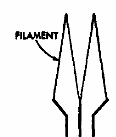
Heat is be further classified by identifying the filament or electron-emitting material.
The materials in regular use are tungsten, thoriated tungsten, and metals which have been coated with alkalineearth oxides.
Tungsten filaments are made from the pure metal.
Because they must operate at high temperatures (a dazzling white) to emit sufficient electrons, a relatively large amount of filament power is required.
Thoriated-tungsten filaments are made from tungsten impregnated with thorium oxide.
Due to the presence of thorium, these filaments liberate electrons at a more moderate temperature of about 1700°C (a bright yellow) and are, therefore, much more economical of filament power than are pure tungsten filaments.
Alkaline earths are usually applied as a coating on a nickel-alloy wire or ribbon.
This coating, which is dried in a relatively thick layer on the filament, requires only a relatively low temperature of about 700-750°C (a dull red) to produce a copious supply of electrons.
Coated filaments operate very elficiently and require relatively little filament power.
However, each of these cathode materials has special advantages which determine the choice for a particular application.
Directly heated filament-cathodes require comparatively little heating power.
They are used in tube types designed for battery operation because it is, of course, desirable to impose as small a drain as possible on the batteries.
They are also used in rectifiers such as the 13GT/1BBGT and the 5Y3GT.
An indirectly heated cathode, or heater-cathode, consists of a thin metal sleeve coated with electron-emitting material such as alkaline-earth oxides.
The emissive surface of the cathode is maintained at the required temperature (approximately 1050°K) by resistance-heating of a tungsten or tungsten-alloy wire which is placed inside the cathode sleeve and electrically insulated from it, as shown in Fig. 2.
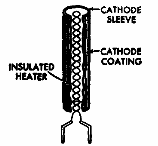
The heater is used only for the purpose of heat-ing the cathode sleeve and sleeve coating to an electron-emitting temperature.
Useful emission does not take place from the heater wire.
A new dark heater insulating coating developed by RCA has better heat transfer than earlier aluminum-oxide coatings, and makes it possible to operate heaters at lower temperatures for given power inputs.
Because the tensile strength of the heater wire increases at the lower operating temperatures, tubes using dark heaters have increased reliability, stability, and life or directly heated heated cathode or cathode. heater-cathode.
The heater-cathode construction is well adapted for use in electron tubes intended for operation from ac power lines and from storage batteries.
The use of separate parts for emitter and heater functions, the electrical insulation of the heater from the emitter, and the shielding effect of the sleeve may all be utilized in the design of the tube to minimize the introduction of hum from the ac heater supply and to minimize electrical interference which might enter the tube circuit through the heater-supply line.
From the view point of circuit design, the heater-cathode construction ofl’ers advantages in connection flexibility because of the electrical separation of the heater from the cathode.
Another advantage of the heater-cathode construction is that it makes practical the design of a rectifier tube having close spacing between its cathode and plate, and of an amplifier tube having close spacing between its cathode and grid. In a close-spaced rectifier tube, the voltage drop in the: tube is low, and, therefore, the regulation is improved.
In an amplifier tube, the close spacing increases the gain obtainable from the tube.
Because of the advantages of the heater-cathode construction, almost all present-day receiving tubes designed for ac operation have heater-cathodes.
Generic Tube Types
Electrons are of no value in an electron tube unless they can be put to work.
Therefore, a tube is designed with the parts necessary to utilize electrons as well as those required to produce them.
These parts consist of a cathode and one or more supplementary electrodes.
The electrodes are enclosed in an evacuated envelope having the necessary connections brought out through air-tight seals.
The air is removed from the envelope to allow free movement of the electrons and to prevent injury to the emitting surface of the cathode.
When the cathode is heated, electrons leave the cathode surface and form an invisible cloud in the space around it.
Any positive electric potential within the evacuated envelope offers a strong attraction to the electrons (unlike electric charges attract; like charges repel).
Such a positive electric potential can be supplied by an anode (positive electrode) located within the tube in proximity to the cathode.
Diodes
The simplest form of electron tube contains two electrodes, a cathode and an anode (plate), and is often called a diode, the family name for a two-electrode tube.
In a diode, the positive potential is supplied by a suitable electrical source connected between the plate terminal and a cathode terminal, as shown in Fig. 3.
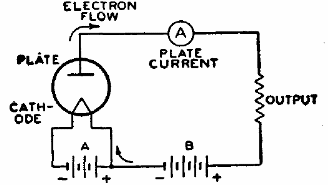
Under the influence of the positive plate potential, electrons flow from the cathode to the plate and return through the external plate-battery circuit to the cathode, thus completing the circuit.
This flow of electrons is known as the plate current.
If a negative potential is applied the plate, the free electrons in the space surrounding the cathode will be force back to the cathode and no plate curent will flow. If an alternating voltag is applied to the plate, the plate is a ternately made positive and negative.
Because plate current flows only during the time when the plate is positive, on current flows through the tube in only on direction and is said to be rectifier,
Fig. 4 shows the rectified output current produced by an alternating input voltage.

Diode rectifiers are used in ac radio ceivers to convert the ac supply voltage to dc voltage for the electrodes of the other tubes in the receiver.
Rectifier tubes having only one plate and one cathode, such as the 35W4, are called half-wave rectifiers, because current can flow only during one-half of the alternating-current cycle.
When two plates and one or more cathodes are used in the same tube, current may be obtained on both halves of the ac cycle.
The 6X4, 5Y3GT, and 5U4GB are examples of this type and are called full-wave rectifiers.
Not all of the electrons emitted by the cathode reach the plate.
Some return to the cathode, while others remain in the space between the cathode and plate for a brief period to produce an effect known as space charge.
This charge has a repelling action on other electrons which leave the cathode surface and impedes their passage to the plate.
The extent of this action and the amount of space charge depend on the cathode temperature, the distance between the cathode and the plate, and the plate potential.
The higher the plate potential, the less is the tendency for electrons to remain in the space-charge region and repel other electrons.
This effect may be noted by applying increasingly higher plate voltages to a tube operating at a fixed heater or filament voltage.
Under these conditions, the maximum number of available electrons is fixed, but increasingly higher plate voltages will succeed in attracting a greater proportion of the free electrons.
Beyond a certain plate voltage, however, additional plate voltage has little effect in increasing the plate current because all of the electrons emitted by the cathode are already being drawn to the plate.
This maximum current, illustrated in Fig. 5, is called saturation current.
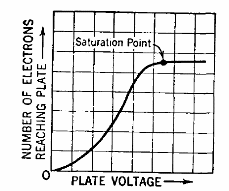
Because it is an indication of the total number of electrons emitted, it is also known as emission current or simply emission.
Although tubes are sometimes tested by measurement of their emission current, it is generally not advisable to measure the full value of emission because this value would be sufficiently large to cause change in the tube characteristics or even to damage the tube.
Consequently, while the test value of emission current is somewhat larger than the maximum current which will be required from the cathode in the use of the tube, it is ordinarily less than the full emission current.
The emission test, therefore, is used to indicate whether the cathode can supply a suflicient number of electrons for satisfactory operation of the tube.
If space charge were not present to repel electrons coming from the cathode, the same plate current could be produced at a lower plate voltage.
One way to make the effect of space charge small is to make the distance between plate and cathode small.
This method is used in rectifier types having heater-cathodes, such as the 5V4GA and the 6AX5GT.
In these types, the radial distance between cathode and plate is only about two hundredths of an inch.
Another method of reducing space-charge effect is utilized in mercury-vapor rectifier tubes.
When such tubes are operated, a small amount of mercury contained in the tube is partially vaporized, filling the space inside the bulb with mercury atoms.
These atoms are bombarded by electrons on their way to the plate.
If the electrons are moving at a sufliciently high speed, the collisions tear off electrons from the mercury atoms.
The mercury atom is then said to be “ionized,” i.e., it has lost one or more electrons and, therefore, has a positive charge.
Ionization is evidenced by a bluish-green glow between the cathode and plate.
When ionization occurs, the space charge is neutralized by the positive mercury atoms so that increased numbers of electrons are made available.
Mercury-vapor tubes are used primarily for power rectifiers.
lonic-heated-catbode rectifiers depend on gas ionization for their operation.
These tubes are of the full-wave design and contain two anodes and a coated cathode sealed in a bulb containing a reduced pressure of inert gas.
The cathode becomes hot during tube operation, but the heating efiect is caused by bombardment of the cathode by ions within the tube rather than by heater or filament current from an external source.
The internal structure of an ionic-heated-cathode tube is designed so that when sufficient voltage is applied to the tube, ionization of the gas occurs be-tween the anode which is instantaneously positive and the cathode.
Under normal operating voltages, ionization does not take place between the anode that is negative and the cathode, so that the requirements for rectification are satisfied.
The initial small flow of current through the tube is suflicient to raise the cathode temperature quickly to incandescence, whereupon the cathode emits electrons.
The voltage drop in such tubes is slightly higher than that of the usual hot-cathode gas rectifiers because energy is taken from the ionization discharge to keep the cathode at operating temperature.
Proper operation of these rectifiers requires a minimum flow of load current at all times to maintain the cathode at the temperature required to supply sufficient emission.
Triodes
When a third electrode, called the control grid, is placed between the cathode and plate, the tube is known as a triode, the family name for a three-electrode tube.
The grid usually consists of relatively fine wire wound on two support rods (siderods) and extending the length of the cathode.
The spacing between turns of wire is large compared with the size of the wire so that the passage of electrons from cathode to plate is practically unobstructed by the grid.
In some types, a frame grid is used.
The frame consists of two siderods supported by four metal straps.
Extremely fine lateral wire (diameter of 0.5 mil or less) is wound under tension around the frame.
This type of grid permits the use of closer spacings between grid wires and between tube electrodes, and thus improves tube performance.
The purpose of the grid is to control the flow of plate current.
When a tube is used as an amplifier, a negative dc voltage is usually applied to the grid.
Under this conditon the grid does not draw appreciable current.
The number of electrons attracted to the plate depends on the combined efiect of the grid and plate polarities, as shown in Fig. 6.
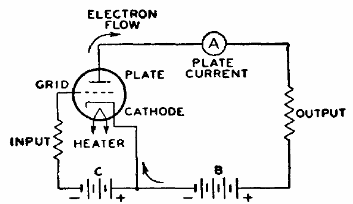
When the plate is positive, as is normal, and the dc grid voltage is made more and more negative, the plate is less able to attract electrons to it and plate current decreases.
When the grid is made less and less negative (more and mare positive), the plate more readily attracts electrons to it and plate current increases.
Hence, when the voltage on the grid is varied in accordance with a signal, the plate current varies with the signal.
Because a small voltage applied to the grid can control a comparatively large amount of plate current, the signal is amplified by the tube.
Typical three-electrode tube types are the 6C4 and 6AF4A.
The grid, plate, and cathode of a triode form an electrostatic system, each electrode acting as one plate of a small capacitor.
The capacitances are those existing between grid and plate, plate and cathode, and grid and cathode.
These capacitances are known as inter-electrode capacitances.
Generally, the capacitance between grid and plate is of the most importance.
In high-gain radio-frequency amplifier circuits, this capacitance may act to produce undesired coupling between the input circuit, the circuit between grid and cathode, and the output circuit, the circuit between plate and cathode.
This coupling is undesirable in an amplifier because it may cause instability and unsatisfactory performance.
Tetrodes
The capacitance between control grid and plate can be made small by mounting an additional electrode, called the screen grid (grid No. 2), in the tube.
With the addition of the grid No. 2, the tube has four electrodes and is, accordingly, called a tetrode.
The screen grid or grid No. 2 is mounted between the grid No. 1 (control grid) and the plate, as shown in Fig. 7, and acts as an electrostatic shield between them, thus reducing the grid-to-plate capacitance.

The efiectiveness of this shield- ing action is increased by a bypass capacitor connected between screen grid and cathode.
By means of the screen grid and this bypass capacitor, the grid-plate capacitance of a tetrode is made very small. In practice, the grid-plate capacitance is reduced from several picofarads (pF) for a triode to 0,01 pF or less for a screen-grid tube.
The screen grid has another desirable efiect in that it makes plate current practically independent of plate voltage over a certain range.
The screen grid is operated at a positive voltage and, therefore, attracts electrons from the cathode.
However, because of the comparatively large space between wires of the screen grid, most of the electrons drawn to the screen grid pass through it to the plate.
Hence, the screen grid supplies an electrostatic force pulling electrons from the cathode to the plate.
At the same time, the screen grid shields the electrons between cathode and screen grid from the plate so that the plate exerts very little electrostatic force on electrons near the cathode.
So long as the plate voltage is higher than the screen-grid voltage, plate current in a screen-grid tube depends to a great degree on the screen-grid voltage and very little on the plate voltage.
The fact that plate current in a screen-grid tube is largely independent of plate voltage makes it possible to obtain much higher amplification with a tetrode than with a triode.
The low grid-plate capacitance makes it possible to obtain this high amplification without plate-to-grid feedback and resultant instability.
In receiving-tube applications, the tetrode has been replaced to a considerable degree by the pentode.
Pentodes
In all electron tubes, electrons striking the plate may, if moving at sufficient speed, dislodge other electrons.
In two- and three-electrode types, these dislodged electrons usually do not cause trouble because no positive electrode other than the plate itself is present to attract them.
These electrons, therefore, are drawn back to the plate.
Emission caused by bombardment of an electrode by electrons from the cathode is called secondary emission because the effect is secondary to the original cathode emission.
In the case of screen-grid tubes, the proximity of the positive screen grid to the plate offers a strong attraction to these secondary electrons, and particularly so if the plate voltage swings lower than the screen-grid voltage.
This effect reduces the plate current and limits the useful plate-voltage swing for tetrodes.
The effects of secondary emission are minimized when a fifth electrode is placed within the tube between the screen grid and plate.
This fifth electrode is known as the suppressor grid (grid No. 3) and is usually connected to the cathode, as shown in Fig. 8.
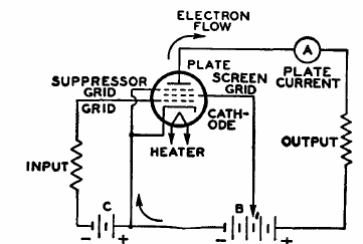
Because of its negative potential with respect to the plate, the suppressor grid retards the flight of secondary electrons and diverts them back to the plate.
The family name for a five-electrode tube is “pentode.”
In power-output pentodes, the suppressor grid makes possible higher power output with lower grid-driving voltage; in radio-frequency amplifier pentodes, the suppressor grid makes possible high voltage amplification at moderate values of plate voltage.
These desirable features result from the fact that the plate-voltage swing can be made very large.
In fact, the plate voltage may be as low as, or lower than, the screen-grid voltage without serious loss in signal-gain capability.
Representative pentodes used for power amplification are the 6CL6 and 6K6GT; representative pentodes used for voltage amplification are the 6AU6A, 6BA6, and 5879.
Beam Power Tubes
A beam power tube is a tetrode or pentode in which directed electron beams are used to increase substantially the power-handling capability of the tube.
Such a tube contains a cathode, a control grid (grid No. l), a screen gn'd (grid No. 2), a plate, and, op- tionally, a suppressor grid (grid No. 3).
When a beam power tube is designed without an actual suppressor grid, the electrodes are so spaced that secondary emission from the plate is suppressed by space-charge efiects between screen grid and plate.
The space charge is produced by the slowing up of electrons traveling from a high-potential screen grid to a lower-potential plate.
In this low-velocity region, the space charge produced is sufficient to repel secondary electrons emitted from the plate and to cause them to return to the plate.
Beam power tubes of this design employ beam-confining electrodes at cathode potential to assist in producing the desired beam effects and to prevent stray electrons from the plate from re- turning to the screen grid outside of the beam.
A feature of a beam power tube is its low screen-grid current.
The screen grid and the control grid are spiral wires wound so that each turn of the screen grid is shaded from the cathode by a grid turn.
This alignment of the screen grid and control grid causes the electrons to travel in sheets between the turns of the screen grid so that very few of them strike the screen grid.
Because of the effective suppressor action provided by space charge and because of the low current drawn by the screen grid, the beam power tube has the advantages of high power output, high power sensitivity, and high efficiency.
Fig. 9 shows the structure of a beam power tube employing space-charge suppression and illustrates how showing beam confining action the electrons are confined to beams.
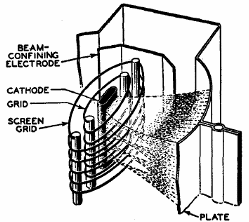
The beam condition illustrated is that for a plate potential less than the screen-grid potential.
The high-density space-charge region is indicated by the heavily dashed lines in the beam.
Note that the edges of the beam-confining electrodes coincide with the dashed portion of the beam.
In this way the space-charge potential region is extended beyond the beam boundaries and stray secondary electrons are prevented from returning to the screen grid outside of the beam.
The spacecharge effect may also be obtained by use of an actual suppressor grid.
Examples of beam power tubes are 6AQ5A, 6L6GC, 6V6GTA, and 50C5..
Multi-Electrode and Multi-Unit Tubes
Early in the history of tube development and application, tubes were designed for a general service; that is, a single tube type-a triode-was used as a radio-frequency amplifier, an intermediate-frequency amplifier, an audio-frequency amplifier, an oscillator, or a detector.
Obviously, with this diversity of application, one tube did not meet all requirements to the best advantage.
Later and present trends of tube design are the development of “specialty” types.
These types are intended either to give optimum performance in a particular application or to combine in one bulb functions which formerly required two or more tubes.
The first class of tubes includes such examples of specialty types as the 6C86A and 6BY6.
Types of this class generally require more than three electrodes to obtain the desired special characteristics and may be broadly classed as multi-electrode types.
The 6BY6 is an especially interesting type in this class.
This tube has an unusually large number of electrodes, namely seven, exclusive of the heater.
Plate current in the tube is varied at two different frequencies at the same time.
The tube is designed primarily for use as a combined sync separator and sync clipper in television receivers.
The second class includes multi-unit tubes such as the twin-diode triodes 6CN7 and 6AV6, as well as triode-pentodes such as the 6U8A and 6X8.
This class also includes class A twin triodes such as the 6CG7 and 12AX7A, and types such as the 6CM7 containing dissimilar triode units used primarily as combined vertical oscillators and vertical deflection amplifiers in television receivers.
Full-wave rectifiers are also multi-unit types.
A third class of tubes combines features of each of the other two classes.
Typical of this third class are the pentagrid-converter types 631-36 and 6SA7.
These tubes are similar to the multi-electrode types in that they have seven electrodes, all of which affect the electron stream; and they are similar to the multi-unit tubes in that they perform simultaneously the double function of oscillator and mixer in superheterodyne receivers.




